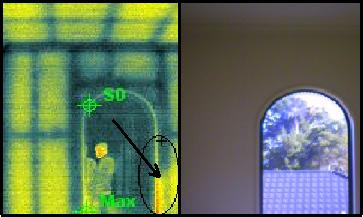What kind of damage can a leak or moisture ingress really do to your home?
How is the structural integrity of your load bearing walls?
Recently during a thermal imaging inspection of a plaster clad home built in the late 90’s, I came across an unwanted finding with the infrared camera.
Can you see what’s missing behind the wall in this infrared thermal photo below?

Correct, that is signs of either rotted of missing timber. Thermal imaging does not see through walls as such, but it usually gives an instant result if there are signs of hidden ‘anomalies’ that can’t be seen with the human eye.
There does actually appear to be timber there when you look closely, but the density of the timber frame around this window looks to have perished on the right hand side. See how it’s very light in colour where the arrow is pointing? This indicates that moisture may have already have ‘been and gone’, and dry rot may have set in.
Let me explain further…
Keep in mind that a thermal imaging camera is only detecting heat radiation, so the reason you can see all the framework in the above image is because where the gib board is touching the timber is a slightly different temperature due to transfer of heat from the timber onto the gib (or visa versa… heat transfer normally travels for hot to cold). So the reason the above image indicates the timber may have lost its integrity, is because the density of the potential dry rot is different to the rest of the sound timber frame around it.
Window leaks are very common with plaster style building construction, especially around window and door frames due to general expansion and contraction of the cladding forced by climatic conditions… hence the term and building method of installing ‘expansion joints’.
Should you buy a home without an infrared building inspection first? You decide.






